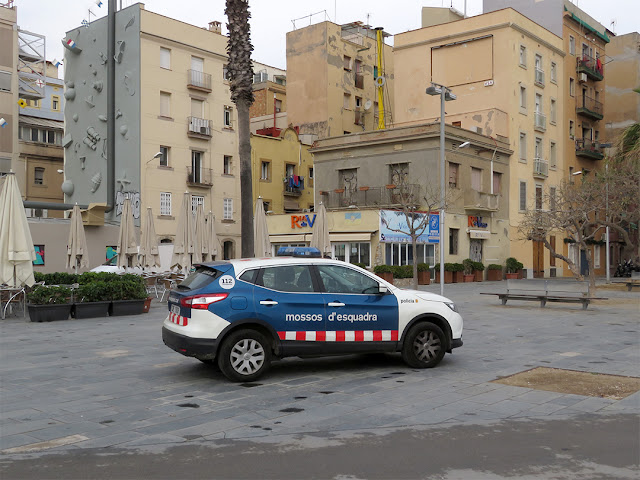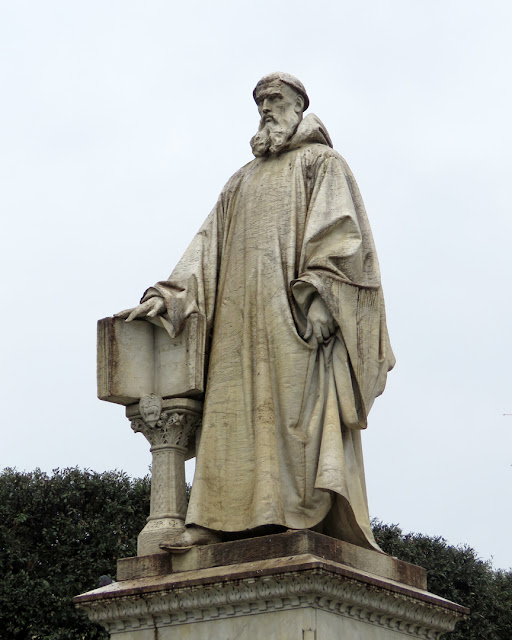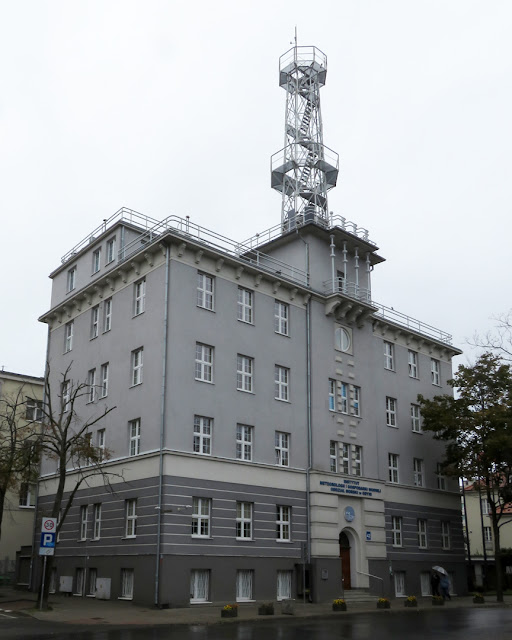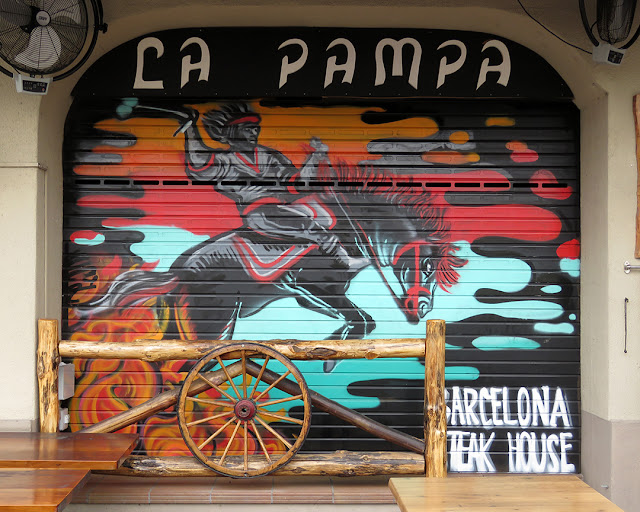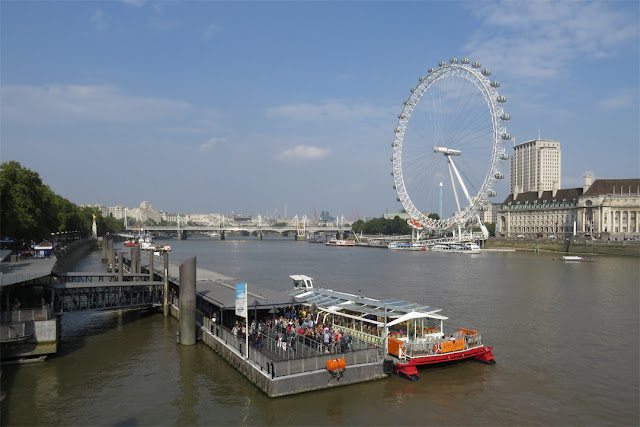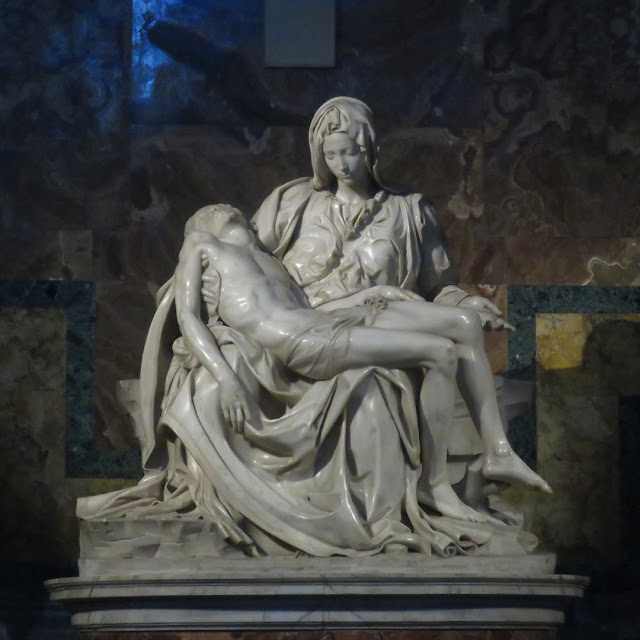Tuesday, November 30, 2021
Via Dora
Quartiere Coppedè
Via Dora
Rome, June 2019
“Quartiere Coppedè is an unexpected and bizarre area in Rome, nestled within the Trieste district in the northern part of the city. The fantastical mix of Ancient Greek, Roman Baroque, Mannerist, Medieval, and, overall, Art Nouveau mishmash was brought to life by Florentine architect Gino Coppedè (from whom the quarter itself takes its current name) in 1919. Coppedè worked on the quarter until his death in 1927. Though the Art Nouveau palaces of Quartiere Coppedè, featuring floral, mythological and medieval details, are abundant, there is plenty of space for the fantasies of Coppedè in this vast area.” (Quartiere Coppedè, Atlas Obscura)
Monday, November 29, 2021
Sunday, November 28, 2021
Saturday, November 27, 2021
Piazza Grande
Apse of Santa Maria della Pieve, the old Tribunal Palace, and the Lay Fraternity
Piazza Grande
Arezzo, February 2021
“The Piazza Grande is the most noteworthy medieval square in the city, opening behind the 13th century Romanesque apse of Santa Maria della Pieve. Once the main marketplace of the city, it is currently the site of the Giostra del Saracino (Joust of the Saracen). It has a sloping pavement in red brick with limestone geometrical lines. Aside from the apse of the church, other landmarks of the square include the Palace of the Lay Fraternity, a 14th–15th century palazzo, with a Gothic ground floor and a quattrocento second floor by Bernardo Rossellino.” (Arezzo, Wikipedia)
Friday, November 26, 2021
Stanisław Moniuszko
Pomnik Stanisława Moniuszki (Monument to Stanisław Moniuszko)
plac Teatralny
Warsaw, September 2018
“Stanisław Moniuszko (May 5, 1819 – June 4, 1872) was a Polish composer, conductor and teacher. He wrote many popular art songs and operas, and his music is filled with patriotic folk themes of the peoples of the former Polish–Lithuanian Commonwealth (mainly Poles, Lithuanians and Belarusians). He is generally referred to as "the father of Polish national opera". Since the 1990s Stanisław Moniuszko is being recognized in Belarus as an important figure of Belarusian culture.” (Stanisław Moniuszko, Wikipedia)
Thursday, November 25, 2021
Mossos d'Esquadra
Mossos d'Esquadra patrol car
Passeig Marítim de la Barceloneta, Barceloneta
Barcelona, March 2017
“The Policia de la Generalitat de Catalunya – Mossos d'Esquadra, commonly known as the Mossos d'Esquadra Squad and informally as Mossos, is the autonomous police force responsible for law enforcement in Catalonia. They trace their origins back to squads formed in 1719.” (Mossos d'Esquadra, Wikipedia)
Wednesday, November 24, 2021
Tuesday, November 23, 2021
Monday, November 22, 2021
Humanity Supporting the World
Humanity Supporting the World by Ernest Cole, 1921
(Designed by Ralph Knott, Joseph and Peter Induni stone carvers)
County Hall
South Bank, Lambeth
London, September 2014
Sunday, November 21, 2021
Guido of Arezzo
Guido of Arezzo (Guido Monaco) by Salvino Salvini, 1882
Piazza Guido Monaco
Arezzo, February 2021
“Guido of Arezzo (c. 991 – after 1033) was an Italian music theorist and pedagogue of the medieval era. He is regarded as the inventor of modern staff notation that replaced neumatic notation. His text, the Micrologus, was the second most widely distributed treatise on music in the Middle Ages (after the writings of Boethius). Guido was a Benedictine monk from the Italian city-state of Arezzo. Recent research has dated his Micrologus to 1025 or 1026; since Guido stated in a letter that he was thirty-four when he wrote it, his birthdate is presumed to be around 991 or 992. His early career was spent at the monastery of Pomposa, on the Adriatic coast near Ferrara. While there, he noted the difficulty that singers had in remembering Gregorian chants. He came up with a method for teaching the singers to learn chants in a short time, and quickly became famous throughout north Italy. However, around 1025 he attracted the hostility of the other monks at the abbey who resisted his musical innovations, prompting him to move to Arezzo, a town which had no abbey, but which did have a large group of cathedral singers, whose training Bishop Tedald invited him to conduct.” (Guido of Arezzo, Wikipedia)
Saturday, November 20, 2021
Institute of Meteorology
Instytut Meteorologii i Gospodarki Wodnej. Oddział Morski
(Institute of Meteorology and Water Management. Maritime Branch)
Jerzego Waszyngtona
Gdynia, September 2018
Friday, November 19, 2021
Thursday, November 18, 2021
Schweizergarde
Swiss Guard
St. Peter's Basilica
Vatican City
Rome, June 2019
“The Pontifical Swiss Guard (also Papal Swiss Guard or simply Swiss Guard; Latin: Pontificia Cohors Helvetica; Italian: Guardia Svizzera Pontificia; German: Päpstliche Schweizergarde; French: Garde suisse pontificale; Romansh: Guardia svizra papala) is a minor armed force and honour guard unit maintained by the Holy See that protects the Pope and the Apostolic Palace within the territory of the Vatican City. Established in 1506 under Pope Julius II, the Pontifical Swiss Guard is among the oldest military units in continuous operation. The dress uniform is of blue, red, orange and yellow with a distinctly Renaissance appearance. The Swiss Guard are equipped with traditional weapons, such as the halberd, as well as with modern firearms. Since the assassination attempt on Pope John Paul II in 1981, a much stronger emphasis has been placed on the Guard's non-ceremonial roles, and has seen enhanced training in unarmed combat and small arms. Recruits to the guards must be unmarried Swiss Catholic males between 18 and 30 years of age who have completed basic training with the Swiss Armed Forces. The unit's security mission is complemented by the Corps of Gendarmerie of Vatican City.” (Swiss Guard, Wikipedia)
Wednesday, November 17, 2021
Józef Poniatowski
Statue of Prince Józef Poniatowski by Bertel Thorvaldsen, 1817
Pałac Prezydencki (Presidential Palace)
Krakowskie Przedmieście
Warsaw, September 2018
“The Prince Józef Poniatowski Monument in Warsaw (Polish: Pomnik księcia Józefa Poniatowskiego w Warszawie) is a monument currently located at 46/48 Krakowskie Przedmieście in the courtyard of the Presidential Palace. Created by Rome-based Danish sculptor Bertel Thorvaldsen in 1829, it depicts Józef Poniatowski (1763–1813) riding and horse and dressed as Roman general. The statue depicts Prince Józef Poniatowski (1763–1813) riding a horse and holding a sword in his right hand. The figure of the prince is modeled on the monument of Marcus Aurelius from the Roman Capitoline Hill. The monument's creation was at the behest of Polish aristocracy. Polish aristocrat and diarist Anna Potocka obtained permission from the Tsar to place the monument in front of the Governor's Palace (which is now the Presidential Palace). The monument was commissioned in 1817 from Danish sculptor Bertel Thorvaldsen. In 1829, in Warsaw, he presented a life-size plaster model in classicist form. The project was not well received by critics and the public who were expecting to see the warrior clad in the armour of a soldier, while Thorvaldsen introduced him as a half-naked Roman general. Based on the model, Klaudiusz and Emil Gregoire's foundry in Długa Street in Warsaw made a bronze cast which was completed in August, 1832. Meanwhile, as a result of the failed November Uprising, Russian consent for the placement of the monument had been withdrawn as part of the Tsar's sanctions against Poland, which was confirmed by a special order in 1834. The finished cast was first taken to the Modlin Fortress, where the sculpture was originally regarded as the patron of the fortress, St. George. In 1836, the monument was dismantled and placed in 10 boxes in the fortress. In 1840, the monument was assembled again, and during an inspection of the fortress by Tsar Nicholas I, it was decided to scrap the monument, but he changed his mind. Later in 1840, the statue was taken to Dęblin, and in 1842 to the Paskevich Palace in Gomel. The monument adorned the palace in Gomel from 1842 to 1922. In Warsaw, a monument to Ivan Paskevich (by sculptors Nikolai Pimienov and Aleksander von Bock) was unveiled in 1870, at the site where Prince Józef Poniatowski's monument was meant to be. Paskevich's statue was pulled down in 1917, when Poland regained independence. The monument to Prince Józef Poniatowski returned to independent Poland in 1922, as part of the recovery of monuments and works of art under the Treaty of Riga. It originally stood in the courtyard of the Royal Castle, and from 1923, in Saxon Square, on a pedestal designed by Aleksander Bojemski in front of the Saxon Palace and the Tomb of the Unknown Soldier. The unveiling ceremony for the monument was associated with the arrival and appointment of Ferdinand Foch as a Marshal of Poland. The monument was blown up on December 16, 1944, on the orders of German General Erich von dem Bach-Zelewski. A new cast of the sculpture, made from 1948 to 1951, based on a model at the Thorvaldsen Museum in Copenhagen, was made by Poul Lauritz Rasmussen, and donated to Warsaw by the Kingdom of Denmark. On February 23, 1952, the monument was placed in front of the Old Orangery (Stara Pomarańczarnia) in Łazienki Park, and in 1965 it was moved to the courtyard of the Presidential Palace where it is today. The remains of the original sculpture, found in April 1945, in the ruins of the Lilpop factory, are exhibited in the Freedom Park at the Warsaw Uprising Museum. Thorvaldsen's original plaster model is on display in the Thorvaldsen Museum in Copenhagen.” (Józef Poniatowski Monument, Wikipedia)
Tuesday, November 16, 2021
Bronze horse heads
Bronze horse heads with chains
County Hall
South Bank, Lambeth
London, September 2014
“The first architectural sculptures to be commissioned for County Hall were the ornamental bronze mooring-rings of horses' and lions' heads on the embankment wall. As has already been mentioned, these were modelled by the sculptor Gilbert Bayes (1872–1953), brother of Walter John Bayes, the Principal of the Westminster School of Art. Bayes, who worked extensively for the Lambeth firm of Doulton, was an exponent of the 'New Sculpture' and interested in the use of mixed media. Knott had suggested him for the embankment wall job, and in October 1909 he was one of three artists invited to submit models for the mooring-rings or ‘dolphins’, the others being Courtney Pollock and Hubert Paton. Not surprisingly, Knott preferred Bayes's model. The casting was carried out by J. W. Singer & Sons, who regularly worked for Hamo Thornycroft and other prominent sculptors. In 1911 the Builder published a drawing by Knott's assistant, J. R. Leathart, of one of the two horse's heads. In 1910 Bayes exhibited his ‘Sigurd’ at the Royal Academy, and it was bought by the Chantrey Bequest and is now in the Tate Gallery. ” (Architectual sculpture and decorative treatment, Survey of London Monograph 17, County Hall)
Monday, November 15, 2021
Duomo di Arezzo
Duomo di Arezzo (Arezzo Cathedral)
Piazza del Duomo
Arezzo, February 2021
“Arezzo Cathedral (Duomo di Arezzo, Cattedrale di Ss. Donato e Pietro) is a Roman Catholic cathedral in the city of Arezzo in Tuscany, Italy. It is located on the site of a pre-existing Palaeo-Christian church and, perhaps, of the ancient city's acropolis. The first cathedral of Arezzo was built on the nearby Pionta Hill, over the burial place of Donatus of Arezzo, martyred in 363. In 1203 Pope Innocent III had the cathedral moved within the city's walls, to the current site. The cathedral however lost the relics of Donatus, which were transferred to the church of San Donato in Castiglione Messer Raimondo (in what is now the province of Teramo). In spite of this, the cathedral is still dedicated to Saint Donatus and at the high altar houses a 14th-century arch named after him.” (Arezzo Cathedral, Wikipedia)
Sunday, November 14, 2021
Jan Paweł II
Bust of Jan Paweł II Papież (Pope John Paul II) by Karol Badyna
ulica Świętej Anny
Stare Miasto (Old Town)
Kraków, September 2018
Saturday, November 13, 2021
Sant Miquel del Port
Església de Sant Miquel del Port (Iglesia de San Miguel del Puerto)
Carrer de Sant Miquel, Barceloneta
Barcelona, March 2017
“Dating from 1755, this sober baroque church was the first building completed in Barceloneta. Built low so that the cannon in the then Ciutadella fort could fire over it if necessary, it was damaged by Leftists in 1936 and restored in 1992. Its sculpture of St Michael (Sant Miquel) has attracted controversy for its depiction of the archangel as a bodybuilder. Also adorning the facade are sculptures of two other saints considered protectors of the Catalan fishing fleet: Sant Elm and Santa Maria de Cervelló. Ferdinand Lesseps, the French engineer who designed the Suez Canal, did a stint as France's consul-general in Barcelona and lived in the house to the right of the church.” (Església de Sant Miquel del Port, Lonely Planet)
Friday, November 12, 2021
Statue of St. Peter
Statue of St. Peter by Arnolfo di Cambio, c.1300
St. Peter's Basilica
Vatican City
Rome, June 2019
“The famous bronze statue of St. Peter is placed against the pillar of St. Longinus, above an alabaster base that was executed in 1757 by Carlo Marchionni. In this statue St. Peter is seated on a marble see from the early Renaissance, dressed with the philosophical stole, with his left hand holding the keys close to his chest and the right raised in the act of blessing. His right foot protrudes from the previously mentioned base, which is worn by the kisses of the devout. The identification of the author but also of its exact epoch, is a ‘vexata quaestio’ which has yet to be resolved, with datings ranging between the fifth, or even fourth century and the 13th or 14th centuries. Tradition has it that the statue was commissioned by St. Leo the Great, as a token of gratitude for defeating Attila, and that it used the metal from the statue by Giove Capitolino. But, in reality, the oldest historical information about the work dates back only to the 15th century. Currently, the almost unanimous opinion is that the Vatican bronze statue dates back to the late 13th century and more specifically to the restricted environment of Arnolfo di Cambio, the artist who created the tabernacles of St. Paul and St. Cecilia, and the sacellum of Bonifacius VIII in the Constantinian Basilica.” (Statue of St. Peter, St. Peter's Basilica - A Virtual Tour)
Thursday, November 11, 2021
Rudolf von Alt
Rudolf von Alt by Hans Scherpe, 1912
Minoritenplatz
Vienna, June 2018
“Rudolf Ritter von Alt (28 August 1812 – 12 March 1905) was an Austrian landscape and architectural painter. Born as Rudolf Alt, he could call himself von Alt and bear the title of a Ritter (knight) after he gained nobility in 1889. Born in Vienna, he was the son of the lithographer Jakob Alt (1789–1871) and the brother of the painter Franz Alt (1821–1914). He studied at the Akademie der bildenden Künste in Vienna. Hiking-trips through the Austrian Alps and northern Italy awoke a love for landscapes, and he painted with his brush using watercolors in a very realistic and detailed style. In 1833, inspired by a visit to Venice and neighbouring cities, he also made a number of architectural paintings.” (Rudolf von Alt, Wikipedia)
Wednesday, November 10, 2021
The wheel and the bridges
Millennium Wheel or London Eye
with the Hungerford Bridge and Golden Jubilee Bridges
South Bank at County Hall
London, September 2014
“The London Eye, or the Millennium Wheel, is a cantilevered observation wheel on the South Bank of the River Thames in London. It is Europe's tallest cantilevered observation wheel, and is the most popular paid tourist attraction in the United Kingdom with over 3 million visitors annually. It has made many appearances in popular culture.” (London Eye, Wikipedia)
Tuesday, November 9, 2021
Francesco Petrarca
Monument to Francesco Petrarca by Alessandro Lazzerini, 1928
Passeggio del Prato
Arezzo, February 2021
“Four metre tall, marble statue of Francesco Petrarca high atop a massive sculptural group, including a busy and eclectic collection of elements drawn from Petrarch's life and poetry. The group right on the front of the base portrays the sentiment of Peace: a mother pulls away her son from fraticidal warfare (on the shield is the text ‘agitans discordia fratres’), clinging to herself. The muscular male youth with arms outstretched, is meant to be crying out for peace, ‘pace, pace, pace’ (the closing of Petrarch's poem ‘Italia mia’). As an allusion to the Triumph of Fame, the main group on the back of the monument shows the poet's coronation with a laurel wreath by Senator Orso dell'Anguillara in 1341. The figures present at the ceremony show the various social classes. Among these are a warrior with the appearance of the Duke of the Abruzzi, a poet with that of Gabriele d'Annunzio and a female figure, where Lazzerini's wife was the model.” (Petrarch, Statues - Hither & Thither)
Monday, November 8, 2021
Sunday, November 7, 2021
Joan Fiveller
Conseller Joan Fiveller (Counsellor Joan Fiveller) by Josep Bover, 1844
Plaça de Sant Jaume
Barcelona, March 2017
Saturday, November 6, 2021
The Piety
The Pietà (The Piety) by Michelangelo Buonarroti, 1499
St. Peter's Basilica
Vatican City
Rome, June 2019
“The Pietà (the Piety; 1498–1499) is a work of Renaissance sculpture by Michelangelo Buonarroti, housed in St. Peter's Basilica, Vatican City. It is the first of a number of works of the same theme by the artist. The statue was commissioned for the French Cardinal Jean de Bilhères, who was the French ambassador in Rome. The sculpture, in Carrara marble, was made for the cardinal's funeral monument, but was moved to its current location, the first chapel on the north side after the entrance of the basilica, in the 18th century. It is the only piece Michelangelo ever signed. It is also the only known sculpture created by a prominent name from the Renaissance era to be installed in St. Peter's Basilica that was accepted by the Chapter of St. Peter.” (Pietà, Wikipedia)
Friday, November 5, 2021
InterContinental Warsaw
InterContinental Warsaw
ulica Emilii Plater
Warsaw, September 2018
“The building is characterised by its unusual shape and is finished in pea-green tones, like the adjacent Warsaw Financial Center. The building houses 414 rooms of various standards, including the presidential suite, 76 luxury suites with kitchenettes, and has 13 conference rooms. The building also has a ballroom, two bars, two restaurants, an E. Wedel chocolate fountain, sauna, fitness club, spa, and solarium. A modern swimming pool, located on the 43rd and 44th floors (150 meters above the ground) is the highest indoor swimming pool in Europe.” (InterContinental Warsaw, Wikipedia)
Thursday, November 4, 2021
The Blackfriar
The Blackfriar
Queen Victoria Street
Blackfriars, City of London
London, September 2014
“The Blackfriar is a Grade II listed public house on Queen Victoria Street in Blackfriars, London. It was built in about 1875 on the site of a former medieval Dominican friary,[3] and then remodelled in about 1905 by the architect Herbert Fuller-Clark. Much of the internal decoration was done by the sculptors Frederick T. Callcott & Henry Poole. The building was nearly demolished during a phase of redevelopment in the 1960s, until it was saved by a campaign spearheaded by poet Sir John Betjeman. It is on the Campaign for Real Ale's National Inventory of Historic Pub Interiors.” (The Blackfriar, Wikipedia)
Wednesday, November 3, 2021
Giorgio Vasari
Giorgio Vasari by Giuseppe Castellucci & Alessandro Lazzerini, 1911
Palazzo delle Logge
Piazza Grande
Arezzo, February 2021
“Marble relief of Vasari, as if he is looking out of a window. It is placed on the first pillar of the loggia designed by him. The relief is designed by Giuseppe Castellucci and executed by Alessandro Lazzerini.” (Giorgio Vasari, Statues - Hither & Thither)
Tuesday, November 2, 2021
Monday, November 1, 2021
Jaume el Conqueridor
Jaume el Conqueridor (James I the Conqueror) by Josep Bover, 1844
Plaça de Sant Jaume
Barcelona, March 2017
“James I the Conqueror (Spanish: Jaime el Conquistador, Catalan: Jaume el Conqueridor; 2 February 1208 – 27 July 1276) was King of Aragon, Count of Barcelona, and Lord of Montpellier from 1213 to 1276; King of Majorca from 1231 to 1276; and Valencia from 1238 to 1276. His long reign—the longest of any Iberian monarch—saw the expansion of the Crown of Aragon in three directions: Languedoc to the north, the Balearic Islands to the southeast, and Valencia to the south. By a treaty with Louis IX of France, he achieved the renunciation of any possible claim of French suzerainty over the County of Barcelona and the other Catalan counties, while he renounced northward expansion and taking back the once Catalan territories in Occitania and vassal counties loyal to the County of Barcelona, lands that were lost by his father Peter II of Aragon in the Battle of Muret during the Albigensian Crusade and annexed by the Kingdom of France, and then decided to turn south. His great part in the Reconquista was similar in Mediterranean Spain to that of his contemporary Ferdinand III of Castile in Andalusia. One of the main reasons for this formal renunciation of most of the once Catalan territories in Languedoc and Occitania and any expansion into them is the fact that he was raised by the Knights Templar crusaders, who had defeated his father fighting for the Pope alongside the French, so it was effectively forbidden for him to try to maintain the traditional influence of the Count of Barcelona that previously existed in Occitania and Languedoc.” (James I of Aragon, Wikipedia)
Subscribe to:
Posts (Atom)






